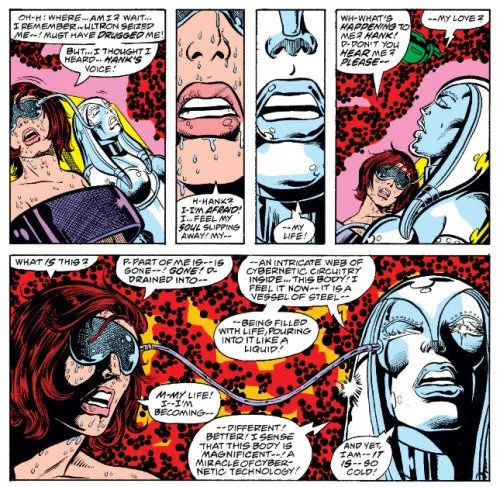Daddy's Issues
Shooter started to put the pieces together during his first run on The Avengers, specifically issues 161 and 162 ("Beware the Ant-Man!" and "The Bride of Ultron," both by Shooter, Perez, and Pablo Marcos). In a clever variation on Hank's first appearance as Yellowjacket, this story has Ant-Man show up at Avengers Mansion with no memory of the past several years; not recognizing his teammates, he attacks them , before being stopped by the Wasp. His psychotic break and assumption of the Yellowjacket identity had let to their marriage; now, he does not even know that Jan is his wife. In all of Shooter's work on the couple, Hank's decline is matched by Jan's ascendence. She had spent her entire career trying to stay within Hank's shadow, no easy task as he shifted from ant-size to giant, but this also means that she has been observing him more closely than anyone. It is Jan who, after knocking her husband out, reminds both her colleagues and the readers just how unstable her husband has always been:
It's almost as if he's never been comfortable with the hero's role that seemed to be demanded of him.
He gave up being the Ant-Man to become Giant-Man--then he took the identity of Goliath--and finally he abandoned his growth powers to become Yellow-Jacket!
Jan reveals that his research was going even worse than his heroic career, with fits of destructive rage that sent her seeking psychiatric advice. That advice (to reinforce his positive behavior) in turn explains some of the more frustrating aspects of Jan's character: her apparent flightiness and incessant good cheer were part of a desperate attempt to prop up her unstable husband's ego.
That ego could never be sufficiently housed in one identity, costume, or even body. In the original appearance of both the Vision and Ultron, Thomas had established that Ultron suffered from an extreme version of the Oedipal complex (hence his desire to kill Pym, his "father"); later, Englehart attributed an Oedipal motivation to Ultron's creation of the Vision as his "son." Now Shooter turns Ultron into Pym's wandering id; like the originally psychotic Yellowjacket, he is free to act out on Pym's repressed desires, even reenacting the original break by erasing Pym's memories of his entire life since his early Ant-Man days (leading him to attack the current Avengers as imposters).
Ultron's scheme here does what he always does, but on a larger scale, bringing together this Oedipal anxieties with Pym's identity crises and inferiority complex in order by externalizing his "father's" endless proliferation of identities onto other, newly created beings. Hank Pym, childless (at least until a twenty-first century retcon), plagued by feelings of inadequacy, can only resort to the same tactic again and again: treating his very self as a canvas onto which to paint a new facade. Ultron may also engage in continually self-improvement (he has only just abandoned calling himself "Ultron 5," or "Ultron 7," as if he were a new version of a popular sports car), but what he really excels at is creating new, artificial lives. If the Vision was the rebellious son, now he will use the brain patterns of the kidnapped Janet Pym and the scientific genius of her addled husband to create a wife for himself, a robotic bride given the very on-the-nose name of Jocasta. Jocasta, like nearly all of Ultron's creations, rebels, allying with the Avengers and existing on the margins of the Marvel Universe for the next several decades. But all of this can be considered the extensions of Hank Pym's messy psyche. And if Jocasta is a robotic version of Jan, her rebellion is also a warning: Hank cannot control her.
Can’t live with ‘em, can’t replace ‘em with a robotic sex toy duplicate
From this description, and with the benefit of hindsight, all of this does not bode well for Jan, or for the Pyms' marriage. Virtually every aspect of Hank's personality (or personalities) is a red flag: his insecurities, his obsessions with work and success, his casual dismissal of Jan's concerns, and, of course, his tendency toward dissociation. In all of these relationships, Jan (and, by extension, Jocasta) is the one element not somehow based on Hank himself. The Ultron-related dramas in which Hank gets entangled are not just Oediipal, but solipsistic. If it weren't for Jan, all his conflicts would be essentially a version of Robert Heinlein's classic story "All You Zombies," only without time travel: everyone turns out to be another version of the story's hero.
Next: Crossing the Line
